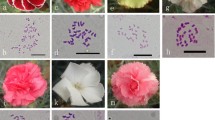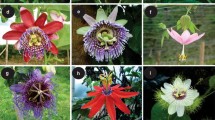Summary
Unidirectional intergeneric crosses using octoploid and hexaploid Fragaria species as a female parent and diploid and tetraploid Potentilla species as a male parent were performed, producing in toto 1345 fruits with an estimated 46089 seeds. The germinating seeds obtained by using P. anserina mostly perished at the cotyledon stage, a few developing into matroclinous octoploid seedlings. The seeds obtained by using P. fruiticosa produced two types of seedlings: matroclinous octoploids and genuine intergeneric hybrids. It is considered that the matroclinous octoploids resulted from contamination during the emasculation process. A great majority of the hybrid seedlings were slow in growth and development and perished before reaching the flowering stage. No haploids have been recovered. Possible reasons for absence of haploid genotypes in the progenies of these intergeneric crosses are considered. Among the seedlings of F. x ananassa cv. Tioga x P. fruiticosa, a seedling of an unusual phenotype was noticed, which upon chromosome determination, proved to be 2n=9x=63. This genotype displayed complete male and female sterility. The implication of the sterility of this seedling for bridging of the two genera is discussed.
Similar content being viewed by others
References
Aalders, E. L., 1964. Production of maternal-type plants through crosses to apomictic species. Nature 204: 101–102.
Askers, S., 1970. An intergeneric Fragaria x Potentilla hybrid. Hereditas 64: 135–139.
Askers, S., 1971. Some viewpoints on Fragaria x Potentilla intergeneric hybridization. Hereditas 64: 181–190.
Barrientos, E. & R. S.Bringhurst, 1973. A haploid of an octoploid strawberry cultivar. HortScience 8: 44.
Bringhurst, R. S. & Y. D. A.Senanayake, 1966. The evolutionary significance of natural Fragaria chiloensis x F. vesca hybrids resulting from unreduced gametes. Amer. J. Bot. 50: 658–661.
Chase, S. S., 1969. Monoploids and monoploids derivatives of maize Zea mays L. Bot. Rev. 35: 117–167.
East, M. E., 1930. The production of homozygotes through induced parthenogensis. Science 72: 148–149.
Ellis, J. R., 1962. Fragaria-Potentilla intergeneric hybridization and evalution in Fragaria. Proc. Linn. Soc. Lond. 173: 99–106.
Hughes, H. G. & J.Janick, 1974. Production of tetrahaploids in the cultivated strawberry. HortScience 9(5): 422–444.
Islam, A. S., 1961. The haploid strawberry, Fragaria vesca L. and the significance of haploidy in phylogeny and plant breeding. Scientist (Pakistan) 4: 1–17.
Kasha, K. J., 1974. Haploids from somatic cells. In: Kasha, K. J. (Ed.), Haploids in higher plants. University of Guelph, Guelph p. 67–87.
Kihara, H., 1940. Formation of haploids by means of delayed pollination in T. monococcum. Bot. Mag. (Tokyo), 54: 173–185.
Magoon, M. C. & K. R.Khanna, 1963. Haploids. Caryologia 16: 191–235.
Mangelsdorf, J. A. & E. M.East, 1927. Studies on the genetics of Fragaria. Genetics 12: 307–339.
Millardet, M. A., 1894. Note sur l'hybridation sans croisement ou fausse hybridation. Mem. Soc. d. Sciences phys. et natur. Bordeus serv. 14: 347–372.
Paris, H. S., O.Shifriss & G.Jelenkovic, 1980. Idiogram of Ricinus communis L. Jour. Hered. 69: 191–196.
Pelouin, S. J., R. W.Hougas & A. C.Cabert, 1966. Haploidy as a new approach to the cytogenetics and breeding of Solanum tubersoum. In: Riley, R. & K. R.Lewis (Ed.), Chromosome manipulations and plant genetics. Plenum Press, New York, p. 21–27.
Rowe, P. E., 1974. Methods of producing haploids: Parthenogensis following interspecific hybridization. In: Kasha, K. J., (Ed.), Haploids in higher plants. University of Guelph, Guelph. p. 43–52.
Sukhareva, N. B., 1970. Elements of apomixis in strawberry. In: Khokhlov, S. S. (Ed.), Apomixis and breeding. Nauka Publishers Moscow, p. 120–123.
Sukhareva, N. B., 1976. Apomixis in strawberry. Proc. Biol. Inst. Sib. Sec. Acad. Sc. USSR 30: 152–164. (In Russian).
Author information
Authors and Affiliations
Additional information
This research was performed as part of a cooperative project on genetic improvement of cultivated strawberry between the Fruit Laboratory, USDA, Beltsville and NJAES. Paper of the Journal Series, D-12102-16-83. New Jersey Agricultural Experiment Station, Rutgers University, New Brunswick, NJ 08903.
Rights and permissions
About this article
Cite this article
Jelenkovic, G., Wilson, M.L. & Harding, P.J. An evaluation of intergeneric hybridization of Fragaria spp. x Potentilla spp. as a means of haploid production. Euphytica 33, 143–152 (1984). https://doi.org/10.1007/BF00022760
Received:
Issue Date:
DOI: https://doi.org/10.1007/BF00022760




